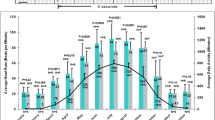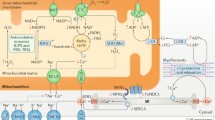Abstract
In the current study on human hibernating myocardium (HHM), we tested the hypothesis that increased glycolysis might exert a positive effect during a supply-demand balance situation by augmentation of myocardial energy formation. In 14 patients HHM was preoperatively detected by clinical methods and validated by the recovery of contractile function three months following revascularization. During open-heart surgery, transmural biopsies were removed from the hibernating areas and analyzed using biochemical and morphologic methods. Metabolite contents were normalized for the degree of fibrosis (control: 9.8 ± 0.5%, HHM 28.1 ± 3.0%; p < 0.05), providing values for cardiomyocytes only. In energy depleted HHM, severe intracellular degeneration, glycogen accumulation and myocyte loss were found. Elevated lactate levels (2.22 ± 0.26 vs. 25.38 ± 3.53 μmol/wet wt, p < 0.001) were indicative of an increased anaerobic glycolytic flux. In conclusion the presence of abundant intracellular glycogen and an increased anaerobic glycolysis in HHM is indicative of a protective adaptation of this myocardium, which might balance energy deficit and may limit structural damage.
Similar content being viewed by others
References
Elsässer A, Schlepper M, Klovekorn WP, Cai WJ, Zimmermann R, Muller KD, Strasser R, Kostin S, Gagel C, Munkel B, Schaper W, Schaper J: Hibernating myocardium: an incomplete adaptation to ischemia. Circulation 96: 2920-2931, 1997
Elsässer A, Decker E, Kostin S, Hein S, Skwara W, Müller KD: A self-perpetuating vicious cycle of tissue damage in human hibernating myocardium. Mol Cell Biochem 213: 17-28, 2000
Elsässer A, Müller K, Skwara W, Bode C, Kübler W, Vogt A: Severe energy deprivation of human hibernating myocardium as possible pathomechanism of contractile dysfunction, structural degeneration and cell death. J Am Coll Cardiol 39: 1189-1198, 2002
Kao R, Rannels DE, Morgan HE: Effects of anoxia and ischemia on protein synthesis in perfused rat hearts. Circ Res 38: I124-I130, 1976
Williams EH, Kao RL, Morgan HE: Protein degradation and synthesis during recovery from myocardial ischemia. Am J Physiol 240: E268-E273, 1981
Leist M, Single B, Castoldi AF, Kuhnle S, Nicotera P: Intracellular adenosine triphosphate (ATP) concentration: A switch in the decision between apoptosis and necrosis. J Exp Med 185: 1481-1486, 1997
Richter C, Schweizer M, Cossarizza A, Francheschi C: Control of apoptosis by the cellular ATP level. FEBS lett 378: 107-110, 1996
Eguchi Y, Shimizu S, Tsujimoto Y: Intracellular ATP levels determine cell death fate by apoptosis or necrosis. Cancer Res 57: 1835-1840, 1997
Depre C, Taegtmeyer H: Metabolic aspects of programmed cell survival and cell death in the heart. Cardiovasc Res 45: 538-548, 2000
Nicotera P, Leist M, Ferrando-May E: Intracellular ATP, a switch in the decision between apoptosis and necrosis. Toxicol Lett 102–103: 139-142, 1998
Camici PG, Wijns W, Borgers M, De Silva R, Ferrari R, Knuuti J, Lammertsma AA, Liedtke AJ, Paternostro G, Vatner SF: Pathophysiological mechanisms of chronic reversible left ventricular dysfunction due to coronary artery disease (hibernating myocardium). Circulation 96: 3205-3214, 1997
Brosius FC, Nguyen N, Egert S, Lin Z, Deeb GM, Haas F, Schwaiger M, Sun D: Increased sarcolemmal glucose transporter abundance in myocardial ischemia. Am J Cardiol 80: 77a-84a, 1997
Depre C, Vanoverschelde J-L, Taegtmeyer H: Glucose for the heart. Circulation 99: 578-588, 1999
King L, Opie L: Glucose and glycogen utilization in myocardial ischemia—changes in metabolism and consequences for the myocyte. Mol Cell Biochem 180: 3-26, 1998
Elsässer A, Müller K, Vogt A, Strasser R, Gagel C, Schlepper M, Klövekorn W: Assessment of myocardial viability: Dobutamine echocardiography and thallium-201 single-photon emission computed tomographic imaging predict the postoperative improvement of left ventricular function after bypass surgery. Am Heart J 135: 463-475, 1998
Vogt AM, Ackermann C, Noe T, Jensen D, Kübler W: Simultaneous detection of high energy phosphates and metabolites of glycolysis and the Krebs cycle by HPLC. Biochem Biophys Res Commun 248: 527-532, 1998
Elsässer A, Schlepper M, Zimmermann R, Muller KD, Strasser R, Klovekorn WP, Schaper J: The extracellular matrix in hibernating myocardium — a significant factor causing structural defects and cardiac dysfunction. Mol Cell Biochem 186: 147-158, 1998
Lieberthal W, Menza SA, Levine JS: Graded ATP depletion can cause necrosis or apoptosis of cultured mouse proximal tubular cells. Am J Physiol 274: F315-F327, 1998
Nagy PV, Feher T, Morga S, Matko J: Apoptosis of murine thymocytes induced by extracellular ATP is dose-and cytosolic pH-dependent. Immunol Lett 72: 23-30, 2000
Chow S, Kass G, Orrenius S: Purines and their roles in apoptosis. Neuropharmacology 36: 1149-1156, 1997
Uren NG, Camici PG: Hibernation and myocardial ischemia: clinical detection by positron emission tomography. Cardiovasc Drugs Ther 6: 273-279, 1992
Malthora R, Brosius FI: Glucose uptake and glycolysis reduce hypoxia-induced apoptosis in cultured neonatal rat cardiac myocytes. J Biol Chem 274: 12567-12575, 1999
Jennings R, Reimer K: The cell biology of acute myocardial ischemia. Annu Rev Med 42: 225-246, 1991
Bing R: Coronary circulation and cardiac metabolism. In: A. Fishman, D. Richards (ed). Circulation of the Blood: Men and Ideals. Oxford University Press, New York, 1964
Bing R: The metabolism of the heart. In: Harvey Lecture Series. Academic Press, New York, 1954–55, pp 27-70
Vary T, Reibel D, Neely J: Control of energy metabolism in heart muscle. Ann Rev Physiol 43: 419-430, 1981
Neely J, Morgan H: Relationship between carbohydrate and lipid metabolism and the energy balance of heart muscle. Annu Rev Physiol 36: 413-459, 1974
Camici P, Dutka D: Repetitive stunning, hibernation, and heart failure: contribution of PET to establish a link. Am J Physiol 280: H929-H936, 2001
Author information
Authors and Affiliations
Rights and permissions
About this article
Cite this article
Vogt, A.M., Elsässer, A., Nef, H. et al. Increased glycolysis as protective adaptation of energy depleted, degenerating human hibernating myocardium. Mol Cell Biochem 242, 101–107 (2003). https://doi.org/10.1023/A:1021141812947
Issue Date:
DOI: https://doi.org/10.1023/A:1021141812947




